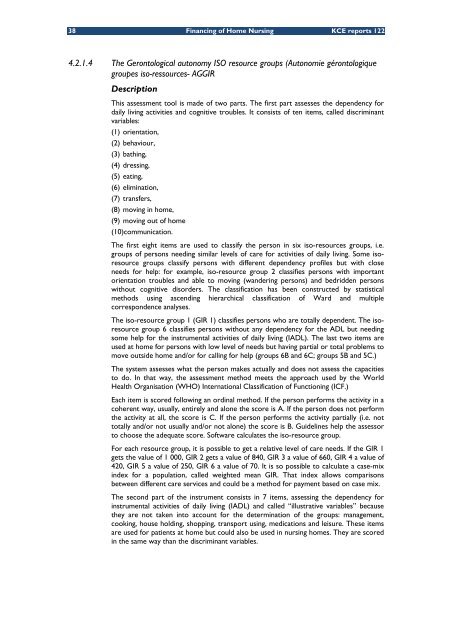Le financement des soins infirmiers à domicile en Belgique - KCE
Le financement des soins infirmiers à domicile en Belgique - KCE
Le financement des soins infirmiers à domicile en Belgique - KCE
Create successful ePaper yourself
Turn your PDF publications into a flip-book with our unique Google optimized e-Paper software.
38 Financing of Home Nursing <strong>KCE</strong> reports 122<br />
4.2.1.4 The Gerontological autonomy ISO resource groups (Autonomie gérontologique<br />
groupes iso-ressources- AGGIR<br />
Description<br />
This assessm<strong>en</strong>t tool is made of two parts. The first part assesses the dep<strong>en</strong>d<strong>en</strong>cy for<br />
daily living activities and cognitive troubles. It consists of t<strong>en</strong> items, called discriminant<br />
variables:<br />
(1) ori<strong>en</strong>tation,<br />
(2) behaviour,<br />
(3) bathing,<br />
(4) dressing,<br />
(5) eating,<br />
(6) elimination,<br />
(7) transfers,<br />
(8) moving in home,<br />
(9) moving out of home<br />
(10)communication.<br />
The first eight items are used to classify the person in six iso-resources groups, i.e.<br />
groups of persons needing similar levels of care for activities of daily living. Some isoresource<br />
groups classify persons with differ<strong>en</strong>t dep<strong>en</strong>d<strong>en</strong>cy profiles but with close<br />
needs for help: for example, iso-resource group 2 classifies persons with important<br />
ori<strong>en</strong>tation troubles and able to moving (wandering persons) and bedridd<strong>en</strong> persons<br />
without cognitive disorders. The classification has be<strong>en</strong> constructed by statistical<br />
methods using asc<strong>en</strong>ding hierarchical classification of Ward and multiple<br />
correspond<strong>en</strong>ce analyses.<br />
The iso-resource group 1 (GIR 1) classifies persons who are totally dep<strong>en</strong>d<strong>en</strong>t. The isoresource<br />
group 6 classifies persons without any dep<strong>en</strong>d<strong>en</strong>cy for the ADL but needing<br />
some help for the instrum<strong>en</strong>tal activities of daily living (IADL). The last two items are<br />
used at home for persons with low level of needs but having partial or total problems to<br />
move outside home and/or for calling for help (groups 6B and 6C; groups 5B and 5C.)<br />
The system assesses what the person makes actually and does not assess the capacities<br />
to do. In that way, the assessm<strong>en</strong>t method meets the approach used by the World<br />
Health Organisation (WHO) International Classification of Functioning (ICF.)<br />
Each item is scored following an ordinal method. If the person performs the activity in a<br />
coher<strong>en</strong>t way, usually, <strong>en</strong>tirely and alone the score is A. If the person does not perform<br />
the activity at all, the score is C. If the person performs the activity partially (i.e. not<br />
totally and/or not usually and/or not alone) the score is B. Guidelines help the assessor<br />
to choose the adequate score. Software calculates the iso-resource group.<br />
For each resource group, it is possible to get a relative level of care needs. If the GIR 1<br />
gets the value of 1 000, GIR 2 gets a value of 840, GIR 3 a value of 660, GIR 4 a value of<br />
420, GIR 5 a value of 250, GIR 6 a value of 70. It is so possible to calculate a case-mix<br />
index for a population, called weighted mean GIR. That index allows comparisons<br />
betwe<strong>en</strong> differ<strong>en</strong>t care services and could be a method for paym<strong>en</strong>t based on case mix.<br />
The second part of the instrum<strong>en</strong>t consists in 7 items, assessing the dep<strong>en</strong>d<strong>en</strong>cy for<br />
instrum<strong>en</strong>tal activities of daily living (IADL) and called “illustrative variables” because<br />
they are not tak<strong>en</strong> into account for the determination of the groups: managem<strong>en</strong>t,<br />
cooking, house holding, shopping, transport using, medications and leisure. These items<br />
are used for pati<strong>en</strong>ts at home but could also be used in nursing homes. They are scored<br />
in the same way than the discriminant variables.

















